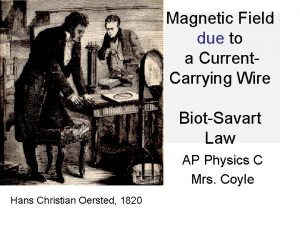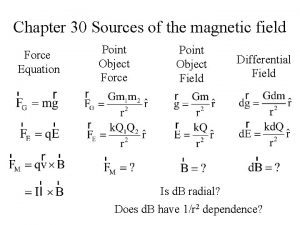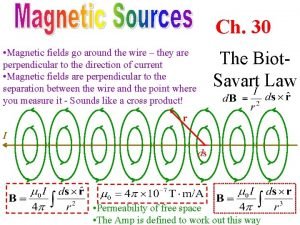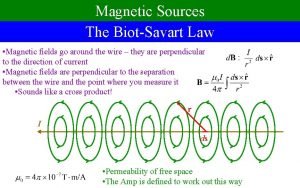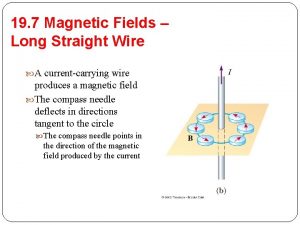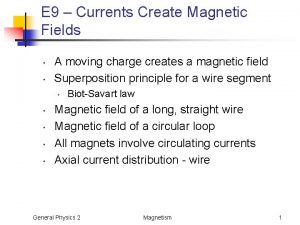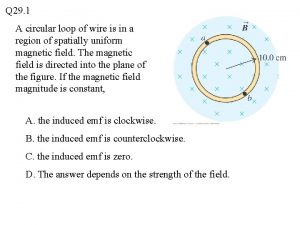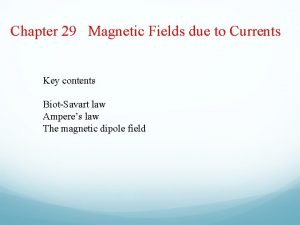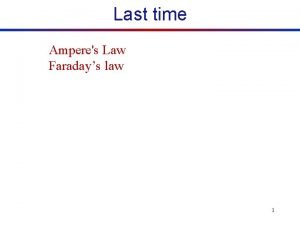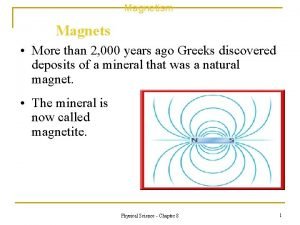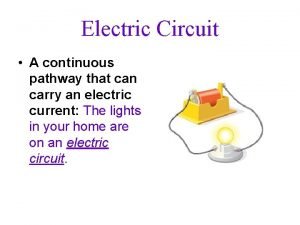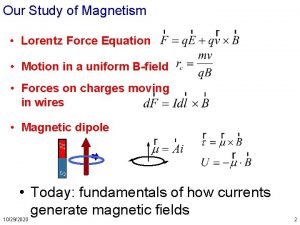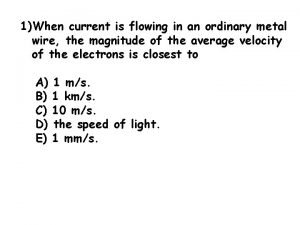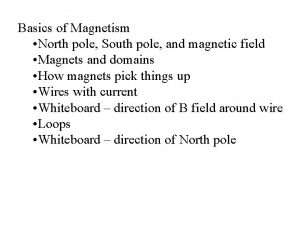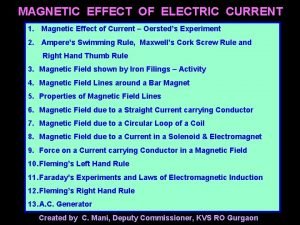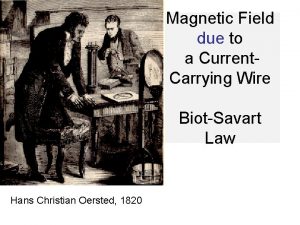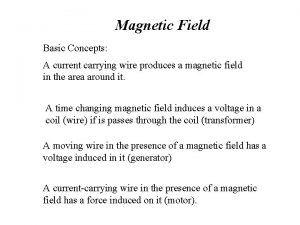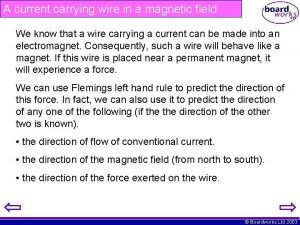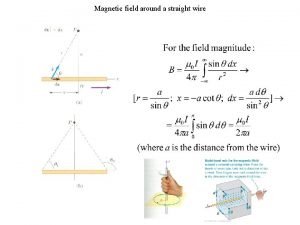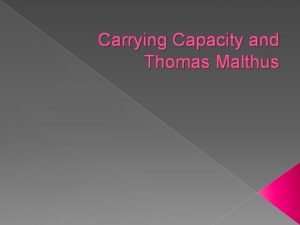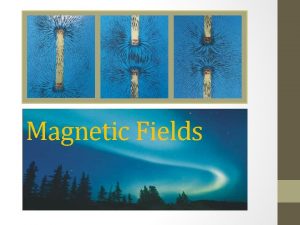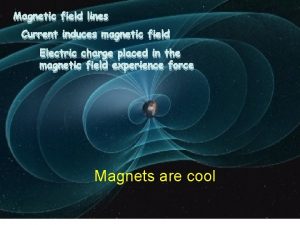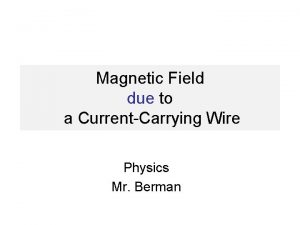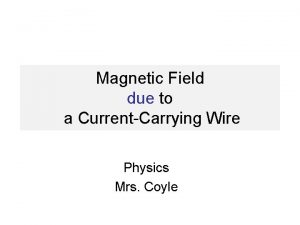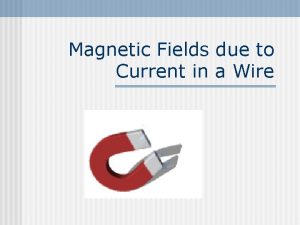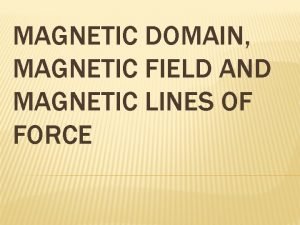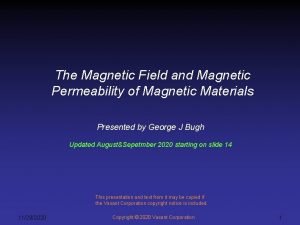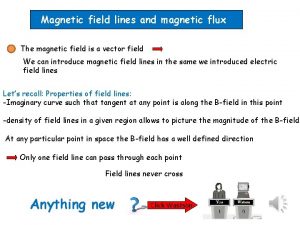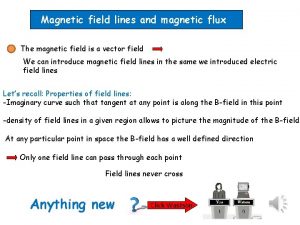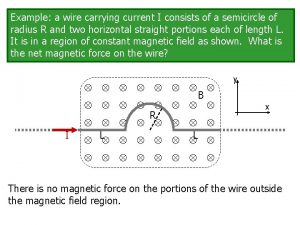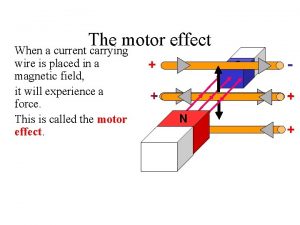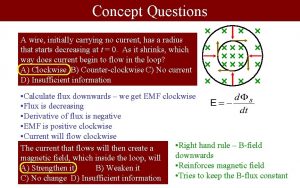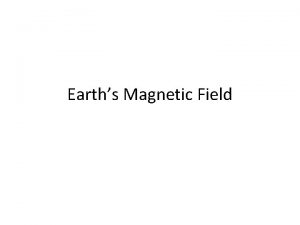Magnetic Field due to a Current Carrying Wire
























- Slides: 24

Magnetic Field due to a Current. Carrying Wire Biot-Savart Law AP Physics C Mrs. Coyle Hans Christian Oersted, 1820

• Magnetic fields are caused by currents. • Hans Christian Oersted in 1820’s showed that a current carrying wire deflects a compass. Current in the Wire No Current in the Wire

Right Hand Curl Rule

Magnetic Fields of Long Current-Carrying Wires B = mo I 2 p r I = current through the wire (Amps) r = distance from the wire (m) mo = permeability of free space = 4 p x 10 -7 T m / A B = magnetic field strength (Tesla) I

Magnetic Field of a Current Carrying Wire • http: //www. walterfendt. de/ph 14 e/mfwire. htm

What if the current-carrying wire is not straight? Use the Biot-Savart Law: Assume a small segment of wire ds causing a field d. B: Note: d. B is perpendicular to ds and r

Biot-Savart Law allows us to calculate the Magnetic Field Vector • To find the total field, sum up the contributions from all the current elements I ds • The integral is over the entire current distribution

Note on Biot-Savart Law • The law is also valid for a current consisting of charges flowing through space • ds represents the length of a small segment of space in which the charges flow. • Example: electron beam in a TV set

Comparison of Magnetic to Electric Field Magnetic Field Electric Field • • B proportional to r 2 Vector Perpendicular to FB , ds, r Magnetic field lines have no beginning and no end; they form continuous circles • Biot-Savart Law • Ampere’s Law (where there is symmetry E proportional to r 2 Vector Same direction as FE Electric field lines begin on positive charges and end on negative charges • Coulomb’s Law • Gauss’s Law (where there is symmetry)

Derivation of B for a Long, Straight Current-Carrying Wire Integrating over all the current elements gives

If the conductor is an infinitely long, straight wire, q 1 = 0 and q 2 = p • The field becomes: a


B for a Curved Wire Segment • Find the field at point O due to the wire segment A’ACC’: B=0 due to AA’ and CC’ Due to the circular arc: • q=s/R, will be in radians

B at the Center of a Circular Loop of Wire • Consider the previous result, with q = 2 p

Note • The overall shape of the magnetic field of the circular loop is similar to the magnetic field of a bar magnet.

B along the axis of a Circular Current Loop • Find B at point P If x=0, B same as at center of a loop

If x is at a very large distance away from the loop. x>>R:

Magnetic Force Between Two Parallel Conductors • The field B 2 due to the current in wire 2 exerts a force on wire 1 of F 1 = I 1 ℓ B 2

Magnetic Field at Center of a Solenoid B = mo NI L N: Number of turns L: Length n=N/L ------------L--------

Direction of Force Between Two Parallel Conductors If the currents are in the: –same direction the wires attract each other. –opposite directions the wires repel each other.

Magnetic Force Between Two Parallel Conductors, FB • Force per unit length:

Definition of the Ampere • When the magnitude of the force per unit length between two long parallel wires that carry identical currents and are separated by 1 m is 2 x 10 -7 N/m, the current in each wire is defined to be 1 A

Definition of the Coulomb • The SI unit of charge, the coulomb, is defined in terms of the ampere • When a conductor carries a steady current of 1 A, the quantity of charge that flows through a cross section of the conductor in 1 s is 1 C

Biot-Savart Law: Field produced by current carrying wires – Distance a from long straight wire – Centre of a wire loop radius R – Centre of a tight Wire Coil with N turns • Force between two wires
 Magnetic field due to a curved wire segment
Magnetic field due to a curved wire segment Magnetic field equation
Magnetic field equation Magnetic field of a finite wire
Magnetic field of a finite wire Magnetic field of a finite wire
Magnetic field of a finite wire Magnetic field for a long straight wire
Magnetic field for a long straight wire Physics 2
Physics 2 A circular loop of wire is in a region of spatially uniform
A circular loop of wire is in a region of spatially uniform Magnetic field outside a wire
Magnetic field outside a wire Electrostatics equations
Electrostatics equations Magnetic moment and magnetic field relation
Magnetic moment and magnetic field relation Magnetic flux units
Magnetic flux units Magnetic field and magnetic force
Magnetic field and magnetic force Magnetic energy formula
Magnetic energy formula Gauss law in magnetism
Gauss law in magnetism Difference between electric field and magnetic field
Difference between electric field and magnetic field Electric field and magnetic field difference
Electric field and magnetic field difference A single wire wrap into a cylindrical wire coil is called
A single wire wrap into a cylindrical wire coil is called Pathway for carrying an electric current
Pathway for carrying an electric current Lorentz force derivation class 12
Lorentz force derivation class 12 When current is flowing in an ordinary metal wire
When current is flowing in an ordinary metal wire Magnetic retentivity
Magnetic retentivity Magneto optical current transformer
Magneto optical current transformer Current magnetic north pole
Current magnetic north pole Snow rule in magnetism
Snow rule in magnetism Due piccole sfere identiche sono sospese a due punti p e o
Due piccole sfere identiche sono sospese a due punti p e o
